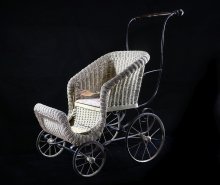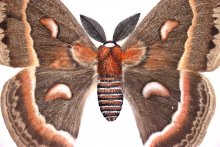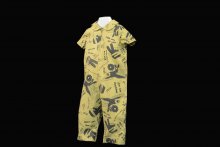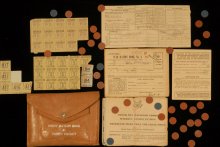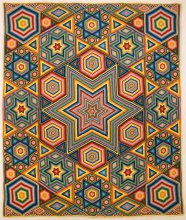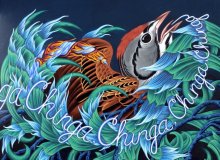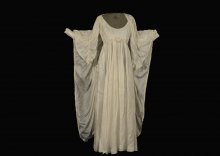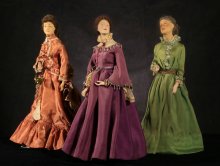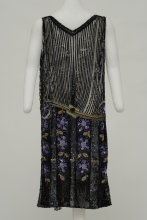Modern Era (1917-present)
The state’s Modern Era has been one of continued growth and change. Following World War I and the nation’s greatest economic collapse, public works projects of the New Deal put people to work on civic projects, such as building roads and infrastructure, and brought history to life by protecting a number of historic places around the state. The Federal Arts Program of the W.P.A. paid artists to create paintings, prints, sculptures, and murals for civic beautification, pride, and capturing the moment. Beginning in 1941, the state’s agricultural and manufacturing sectors and the sacrifices of citizen-soldiers played an important role in making the United States a leader on the world stage.
Augusta Margaret was born in 1917 to Harley and Lillian Linebarger of Edgar County. In 1920, she developed juvenile diabetes, for which there was no known treatment at the time. Unable to metabolize sugar, Augusta Margaret could not derive adequate nutrition from the food she ate. In an effort to prolong her life, her parents developed special menus for her and took her repeatedly to the hospital in Danville. Ultimately, a doctor wrote to them and told them that he could offer no hope for their little girl. As she grew too frail to walk, her parents took her out in this stroller.
Today, anyone can share color photos of butterflies and moths by simply uploading them to social media. It wasn't so easy 120 years ago, when technology to capture color photographs and print the pictures on a page was in its infancy.
Opposition to American involvement in the Vietnam War began with small demonstrations on college campuses in 1964. By the end of the decade, anti-war sentiment had grown into a broad social movement that sparked a counterculture revolution.
America’s entry into World War II resulted in nationwide efforts to mobilize and equip the military in preparation for battle. Diversion of resources to the troops and Allies resulted in food shortages at home: processed and canned food was largely reserved for shipping overseas to the military and our Allies, transportation of fresh food was limited due to gasoline and tire rationing, and restrictions on imports limited the availability of products from abroad such as coffee and sugar. In 1942, the United States Office of Price Administration instituted food rationing to ensure the fair distribution of goods that were in short supply.
After teasing his wife and daughter about the workmanship of one of their quilts, Albert Small was tartly asked if he could do any better. “I can and I will,” he replied and bet them that he could make his own quilt using more pieces of smaller size than anything they could produce. Albert was a foreman at the Ottawa Silica Plant; he had no quiltmaking experience. Nevertheless, after working with dynamite and heavy machinery all day, he picked up his needle and thread at night and succeeded in creating a quilt out of more than 36,000 hexagon-shaped pieces.
Like naturalist illustrations on steroids, Kevin Veara's paintings contain the precision and crisp detail found in John J. Audubon prints but without Audubon's formulaic natural settings. Veara surrounds his birds in exotically-colored patterned environments, bringing to mind the way contemporary painter Kehinde Wiley employs highly-stylized patterning as wallpaper that surrounds his figural paintings in order to critique Western Art history and obliterate cultural boundaries.
Springfield, Illinois, artist Kevin Veara paints birds against eye-popping backdrops of imagined, mutant hybrid flora. His paintings comment on the extraordinary beauty of these birds that are forced to coexist or become extinct in an ever-changing modern environment. Some of his paintings also include the birdcalls in bold, glowing, cursive phonetics, a nod to both early 19th century naturalist studies and tattoo art.
Nancy Batchelder wore this dress when she married David Fryxell on May 1, 1982. It was made from her father's World War II silk parachute. Walter Batchelder was hospitalized and unable to attend his daughter’s wedding, so Nancy made the dress as a tribute to him and as a way of having her father represented on her big day.
These three wax figurines are representatives from a collection of 129 figurines depicting outstanding women in Illinois history. They were created by Minna Schmidt and donated to the Illinois State Historical Library in 1929. Harriet Sanger Pullman, left, was a socialite who supported hospitals, libraries, and schools. Julia Dent Grant, center, was the loving wife of Ulysses S. Grant. Elizabeth Byerly Bragdon, right, was a patron of music and the arts.
This heavy, elaborately embellished dress comes straight out of Jazz Age Paris, where Anna King purchased it in 1926. Flapper dresses like these were specifically designed for dancing, as movement accentuates the dress.
Pages






